Home-made biogas anaerobic digester
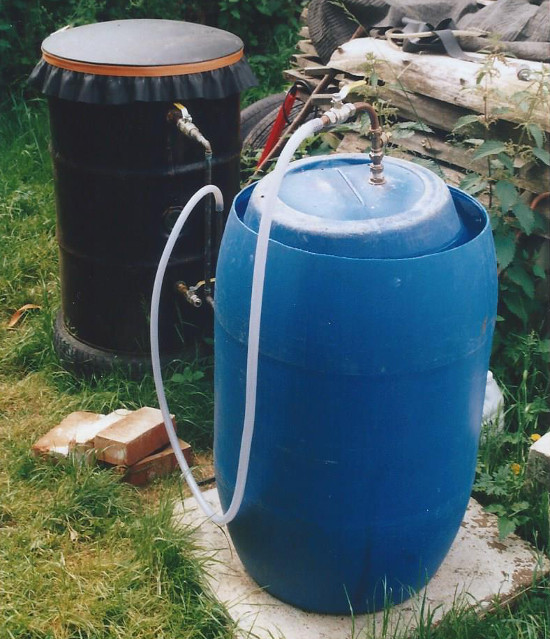
Thought you might like this. Just came across an old photo of a simple biogas digester built by Lowimpact.org co-founder Phil when we were based at Redfield Community in Buckinghamshire.
It was a little experiment to find how much biogas could be produced from a tiny system with an oil drum for a digestion chamber. It’s ideal for a smallholder with livestock or somewhere with lots of cooked food waste. We put animal manure and cooked food waste into the drum, and made the top airtight with a neoprene skin, tightened with a ratchet strap.
Then there’s a ‘gas container’ consisting of two large plastic orange juice barrels with the tops cut off, one slightly larger than the other. The large barrel was filled with water, and the second one was upturned, and a pipe with a tap fixed to it. It was then introduced into the larger barrel (with the tap open) until it was filled with water. A flexible hose connected the pipe from the upturned barrel to a pipe from the top of the oil drum.
As the waste decomposed anaerobically it gave off gas which made the neoprene ‘lid’ bulge. When this happened, both taps were opened and the pressure forced the gas through the pipe into the gas container. The water in the large barrel acted as a seal to stop the gas escaping, and the small barrel rose out of the water. When the small barrel had risen almost a metre from the surface of the water, both taps were closed. We now had a store of biogas, and the bulge in the neoprene lid had gone.
Then the flexible hose was removed from the pipe from the oil drum and attached to a small camping gas hob, and several meals could be cooked until the gas had all gone and the small barrel had again fallen to the level shown in the photo. But then more waste had been added to the digester and the process was repeated to store more gas.
After a few cycles the oil drum was emptied and the contents put onto the compost heap. This digester could be positioned outside the kitchen and the gas piped through the wall to the hob. With a few animals and/or a supply of food waste, it could be possible to provide enough gas for cooking for a family. In fact, in India, it’s estimated that over 2 million families do just that – see image below.
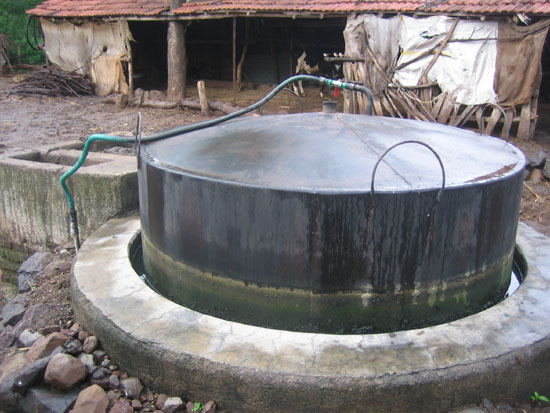
The views expressed in our blog are those of the author and not necessarily lowimpact.org's
11 Comments
-
1morgan rook March 9th, 2016
Nice experiment! How far did you fill the digester, and when did you decide that was done?
-
2Dave Darby March 9th, 2016
If I remember correctly, about half full, and it’s done when the neoprene cover stops bulging any more (then empty it onto the compost heap and put a new batch in).
-
3Adam Short April 15th, 2016
are there any UK communities / individuals offering their talents to install such things? We’re scrapping the inherited oil burner shortly, and replacing it with an old rayburn or such like. I’d love to have a bio-gas powered hob in addition.
-
4Dave Darby April 15th, 2016
We don’t have anyone in the directory for that as yet, so it’s a google, or if you only want a hob, you could do a DIY job like the one above (I know that there are installers for farms, but you may not find anyone for just a hob, so it might have to be DIY).
-
5Adam Short April 19th, 2016
It’s the one in the 2nd picture that I’d be aiming for, to fuel a multi-ring hob for “average” family cooking. I’d then need the blue-barrel solution from the first picture to provide a “local bank” just outside the kitchen wall. I’ve got a pile of questions about the construction and operation of the larger one which are not yet answered by the online materials (I will keep looking of course)…. All systems seem to show input and output pipes on opposide sides of the slurry tank – is the movement of “raw” to “used” matter really just lateral flow through the tank? Does the tank ever have to be totally emptied during normal operation? detailed limitations of the raw food – most seem to mainly reference manure with food waste as a secondary, but no detail on the food waste size/consitency/type? That sort of thing ? I’m happy to build it and have a go (and write it up for LILI), but I’d like to meet up with someone with practical experience first if possible.
-
6Dave Darby April 19th, 2016
Hi Adam,
I don’t personally know a specialist, but you could try these guys – http://www.breg.org.uk/
Also, you could post something in the comments section at the bottom of this page – http://lowimpactorg.wpengine.com/lowimpact-topic/biogas/
That’s where you’re most likely to catch someone with specialist knowledge in larger-scale biogas (and there’s google of course)
cheers and good luck.
and yes, we’d love to send us your experiences for an article.
-
7Mike Eaton December 23rd, 2017
Of some interest at a guess there is a small book from Mother Earth News entitled “The Mother Earth News Handbook of Homemade Power”, my copy is dated 1974! The section on Methane covers a version of the system above – well worth a read IF YOU CAN GET HOLD OF A COPY – having said that I believe there is a good chance obtaining a copy if you contact Mother Earth. It cost me about 60p back in 1974, probably slightly more by now, but well worth it
-
8Dave Darby December 23rd, 2017
you can get hold of a copy – https://www.alibris.co.uk/The-Mother-Earth-News-handbook-of-homemade-power/book/4476782?matches=10
but it’s more than 60p now
-
9Adrian June 1st, 2020
Hi Dave,
do you know how UV-resistant the barrels are? I’m curious how durable the biogas digester is and how long it can be used.
-
10Dave Darby June 2nd, 2020
Adrian – sorry, this kit was made a long time ago now – they were big commercial orange juice containers if I remember rightly, but I don’t know about their uv resistance.
-
11Chester L Moeletsi August 4th, 2023
Tried many times in South Africa but with no supportive luck. Would like to be a baby of nations to learn from. So your comments and sending through pictures on how to assemble the mini plant may assist a lot in rural areas.




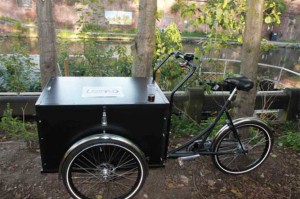 Cargo bikes collecting local food waste for anaerobic digestion and biogas
Cargo bikes collecting local food waste for anaerobic digestion and biogas
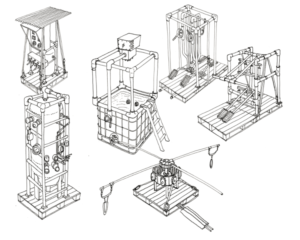 The great Human Power Plant experiment
The great Human Power Plant experiment
 Feeding the Human Power Plant: can calories be carbon-neutral?
Feeding the Human Power Plant: can calories be carbon-neutral?
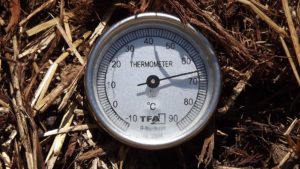 How to get 500 hot showers from your compost heap!
How to get 500 hot showers from your compost heap!
 How to support anaerobic digestion for biogas and compost in communities
How to support anaerobic digestion for biogas and compost in communities
 Biogas
Biogas


